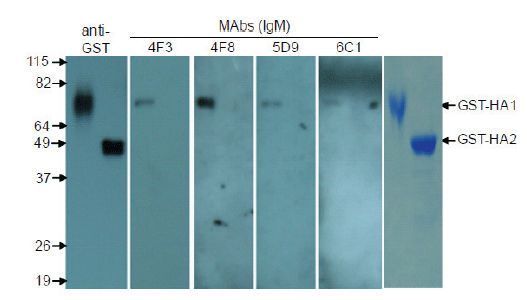Anti-Influenza A (H5N1) Hemagglutinin (HA) [4F8/H3] Antibody
This mouse IgM monoclonal antibody were raised against recombinant Hemagglutinin protein (HA) (H5N1) full-length protein expressed in insect cells and recognizes HA protein from Influenza A virus H5N1.
Highlights:
- Reacts with RNA dependent RNA polymerase R2 of SARS-CoV
- Suitable for Western Blot applications
The highly pathogenic avian influenza A subtype H5N1 virus was first isolated from geese in Guangdong province, China, in 1996. Since 2003, the H5N1 strains have caused major morbidity and mortality in poultry populations across Asia, Europe, and Africa. The hemagglutinin (HA) protein is one of the two major surface glycoproteins on the envelope of influenza A virus, with 16 distinct types identified in the avian species. The
HA protein is responsible for receptor binding to host cells and for viral entry and is therefore the primary target of neutralizing antibodies. In this study, the recombinant HA protein of a clade H5N1 virus was used to generate monoclonal antibodies.
From the laboratory of A*STAR Institute of Molecular and Cell Biology (IMCB) Monoclonal Antibody Unit.
This mouse IgM monoclonal antibody were raised against recombinant Hemagglutinin protein (HA) (H5N1) full-length protein expressed in insect cells and recognizes HA protein from Influenza A virus H5N1.
Highlights:
- Reacts with RNA dependent RNA polymerase R2 of SARS-CoV
- Suitable for Western Blot applications
The highly pathogenic avian influenza A subtype H5N1 virus was first isolated from geese in Guangdong province, China, in 1996. Since 2003, the H5N1 strains have caused major morbidity and mortality in poultry populations across Asia, Europe, and Africa. The hemagglutinin (HA) protein is one of the two major surface glycoproteins on the envelope of influenza A virus, with 16 distinct types identified in the avian species. The HA protein is responsible for receptor binding to host cells and for viral entry and is therefore the primary target of neutralizing antibodies. In this study, the recombinant HA protein of a clade H5N1 virus was used to generate monoclonal antibodies.
From the laboratory of A*STAR Institute of Molecular and Cell Biology (IMCB) Monoclonal Antibody Unit.
| Product Type: | Antibody |
| Antigen: | Hemagglutinin protein from Influenza A virus H5N1 |
| Accession ID: | P03454 |
| Molecular Weight: | 63 kDa |
| Isotype: | IgM |
| Clonality: | Monoclonal |
| Clone Name: | 4F8/H3 |
| Reactivity: | Influenza A virus |
| Immunogen: | Recombinant HA (H5N1) full-length protein expressed in insect cells |
| Species Immunized: | Mouse |
| Buffer: | Cell culture supernatant |
| Tested Applications: | WB |
| Storage: | -80C |
| Shipped: | Cold Packs |
Western Blot

Purified fragments of HA corresponding to the HA1 and HA2 domains were separated on SDS-polyacrylamide gels and analyzed in Western blots using ascites fluid for each MAb. For the last gel, commassie blue staining was performed to ascertain the purity of the HA1 and HA2 proteins used.
From the laboratory of A*STAR Institute of Molecular and Cell Biology (IMCB) Monoclonal Antibody Unit.
If you publish research with this product, please let us know so we can cite your paper.

![Anti-Influenza A (H5N1) Hemagglutinin (HA) [4F8/H3] Antibody Anti-Influenza A (H5N1) Hemagglutinin (HA) [4F8/H3] Antibody](https://www.kerafast.com/MediaStorage/Product/Images/Medium/1747_2001202001270017460.jpg)
